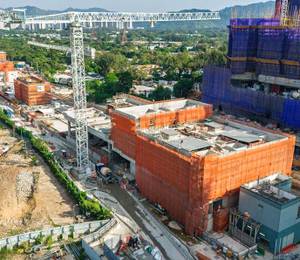With efforts to boost infrastructure development on the agenda over the next few years, countries across Southeast Asia will likely see greater adoption of advanced technologies to address challenges and improve efficiency. Kaushik Chakraborty, senior vice president of Asia Pacific at Bentley Systems, recently spoke with Southeast Asia Construction (SEAC) to highlight the benefits of digital twins for the construction industry.
‘More than just a BIM model’
As a highly accurate virtual representation of a physical asset, a digital twin is “…more than just a BIM model. It is integrated with a lot of additional information from a variety of sources,” explained Mr Chakraborty. “In a digital twin, you have many different layers and inputs, which come not only from engineering information but also from IT and operational information. A 3D BIM model is just one of these inputs.
“With a digital twin, you can see the actual existing conditions of an asset, which a BIM model cannot provide – like how the temperature sensor in a building operates, or whether the lighting systems work properly. So, a digital twin takes a BIM model and adds a lot of other information to create a true interpretation of the entire asset.”
Beyond 3D digital twins
A 3D digital twin can be combined with the fourth and fifth dimensions – namely project schedule and project cost respectively – to create 4D and 5D digital twins.
“The use of 4D and 5D digital twins can reduce costs further,” said Mr Chakraborty, “because clients can improve their project planning and manage their budget (e.g. for construction materials, labour, etc) more effectively.”
According to Mr Chakraborty, a number of projects in Singapore have already implemented 4D digital twin solutions. As for 5D digital twins, these are likely to be used in more complex projects such as infrastructure development, he revealed. “Relatively speaking, building projects are much simpler, whereas infrastructure projects like rail and transport require a much higher capital expenditure, and they also have more complex scenarios.”
Bentley offers 3D/4D/5D digital twin solutions through its Synchro construction management software, which covers the whole lifecycle: from project planning all the way to project management. On-demand training sessions are also available online for global users.
Corey Johnson, senior director of product management at Bentley Systems, recently shared with SEAC the benefits of Synchro for developing model-based digital workflows, especially in civil infrastructure construction. “Clients can use Synchro to upgrade their 2D models to 3D/4D/5D digital twins, allowing for a much easier process,” he said, adding that “currently, there are not many software technology platforms on the market that have such capability.”
“Bentley digital platforms work with all competitor products, with different IT systems, and are able to integrate data from different operational systems,” elaborated Mr Chakraborty.
Another advantage of digital twin technology is that it can be used to help preserve heritage buildings. An example of this is the preservation of St. Peter’s Basilica in Vatican City, one of the world’s most famous historical landmarks. Italy-based engineering company Italferr SpA was hired to develop a digital twin of the church.
To meet the six-month timeline, Italferr called upon integrated and open 3D modelling and digital twin technology. The company relied on Bentley’s ProjectWise, iTwin Capture and MicroStation to manage 3 terabytes of multisourced data and generate a digital twin model to be shared among 30 people. Working in a collaborative digital environment saved 50 hours in modelling time, delivering the model 20 days ahead of schedule.
“Creating a digital twin is like undergoing a full health check-up, where you can gain insights into everything about your condition in one go,” described Mr Chakraborty. “When all the different parameters have been put together, your doctor will be able to decide whether you’re healthy or not.
“And, just like our health needs constant monitoring, maintaining and updating a digital twin is important because as the asset ages, the data changes.”
Fostering collaboration
In Southeast Asia alone, key infrastructure projects are already underway, some of which have embraced digital twins, such as the Johor Bahru-Singapore RTS Link and a road section for Indonesia’s new capital city.
Nevertheless, with its use still relatively uncommon, Mr Chakraborty acknowledged that wider acceptance of digital twins remains a challenge in Southeast Asia. “Each country has its own approach; however, people in Singapore – across all age groups – tend to be more receptive of new technologies and can learn faster in general,” he noted.
“BCA [Singapore’s Building and Construction Authority] has been promoting the use of new technologies for many years through various initiatives, such as subsidies, to help the industry progress. BCA is also actively pushing the effort through education, and this excites the younger generations to come and work in Singapore.”
He added that the Singapore government “has further encouraged strong collaboration among project teams, which is not a common practice in other Southeast Asian countries.”
This lack of collaboration can pose problems, because implementing a digital twin application requires “all project team members to cooperate with each other, share data and be transparent,” stressed Mr Chakraborty.
With Singapore now shifting towards adopting a collaborative contracting model for the delivery of construction projects, digital twins – and other advanced technologies – could well play a bigger role in the industry.
“It should definitely be a value-add and will foster collaboration,” Mr Chakraborty concluded. “The use of digital twin technology will force everybody in the project team to work together and be transparent, share information and data, and ensure that there is a single source of truth for the project. The greater the collaboration, the lower the project risks – and it makes disputes easier to resolve.”
Image 2: AECOM Perunding Sdn Bhd
Image 3: Italferr SpA













